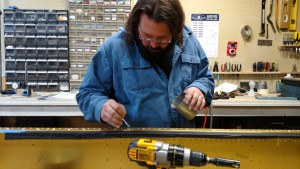Measuring every freaking hole is probably overkill, but 1/20 weren’t deep enough the first time.
Non-optional priming of areas where anodizing was removed by the countersinking. Q-tip dipped in primer sprayed into cup from rattle can.
.032″ “scrap” (we didn’t have any, had to order some), drilled, dimpled and turned into gauge.
If I’m going to have to prime the areas the anodizing was removed, I might as well prime the inexplicable 5″ spar extension.
Berck: 9 hours, Jonah: 2.75 hours


















